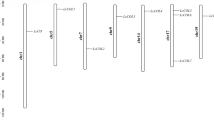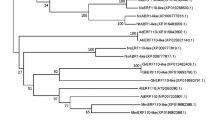Abstract
Photoperiod and vernalization are the two key environmental factors of the floral induction of perennial ryegrass (Lolium perenneL.). Transition from vegetative to reproductive growth will only occur after an extended vernalization period, followed by an increase in day length and temperature. Here we report on the isolation and characterization of a L. perennegene (LpCO) that is homologous to CONSTANS, and which is tightly coupled to the floral inductive long day signal. Like other monocot CO-like proteins, the LpCO contains a zinc finger domain with a non-conserved B-Box2. Although the B-Box2 has been demonstrated to be essential for the function of the ArabidopsisCO (AtCO), LpCO is able to complement the Arabidopsis co-2 mutant, and ectopic expression in Arabidopsis wild type leads to early flowering. The LpCO transcript exhibits diurnal oscillations and is expressed at higher levels during long days.
Similar content being viewed by others
References
Aamlid, T.S., Heide, O.M. and Boelt, B. 2000. Primary and secondary induction requirements for flowering of contrasting European varieties of Loliumperenne. Ann. Bot. 86: 1087-1095.
Bernier, G. 1988. The control of floral evocation and Morphogenesis. Ann. Rev. Plant Physiol. Plant Mol. Biol. 39: 175-219.
Borden, K.L.B. 1998. RING fingers and B-boxes: zinc-binding protein-protein interaction domains. Biochem. Cell Biol.-Biochim. Biol. Cell. 76: 351-358.
Cao, T.Y., Duprez, E., Borden, K.L.B., Freemont, P.S. and Etkin, L.D. 1998. Ret finger protein is a normal component of PML nuclear bodies and interacts directly with PML. J. Cell Sci. 111: 1319-1329.
Clough, S.J. and Bent, A.F. 1998. Floral dip: a simplified method for Agrobacterium-mediated transformation of Arabidopsis thaliana. Plant J. 16: 735-743.
Fowler, S., Lee, K., Onouchi, H., Samach, A., Richardson, K., Coupland, G. and Putterill, J. 1999. GIGANTEA: a circadian clock-controlled gene that regulates photoperiodic flowering in Arabidopsis and encodes a protein with several possible membrane-spanning domains. EMBO J. 18: 4679-4688.
Gocal, G.F.W., King, R.W., Blundell, C.A., Schwartz, O.M., Andersen, C.H. and Weigel, D. 2001. Evolution of floral meristem identity genes. Analysis of Lolium temulentum genes related to APETALA1 and LEAFY of Arabidopsis. Plant Physiol. 125: 1788-1801.
Griffiths, S., Dunford, R.P., Coupland, G. and Laurie, D.A. 2003. The evolution of CONSTANS-like gene families in barley, rice and Arabidopsis. Plant Physiol. 131: 1855-1867.
Hayama, R., Yokoi, S., Tamaki, S., Yano, M. and Shimamoto, K. 2003. Adaptation of photoperiodic control pathways produces short-day flowering in rice. Nature 422: 719-722.
Heide, O.M. 1994. Control of flowering and reproduction in temperate grasses. New Phytol. 128: 347-362.
Izawa, T., Oikawa, T., Sugiyama, N., Tanisaka, T., Yano, M. and Shimamoto, K. 2002. Phytochrome mediates the external light signal to repress FT orthologs in photoperiodic flowering of rice. Genes Dev. 16: 2006-2020.
Kardailsky, I., Shukla, V.K., Ahn, J.H., Dagenais, N., Christensen, S.K., Nguyen, J.T., Chory, J., Harrison, M.J. and Weigel, D. 1999. Activation tagging of the floral inducer FT. Science 286: 1962-1965.
Karimi, M., Inze, D. and Depicker, A. 2002. GATE-WAY((TM)) vectors for Agrobacterium-mediated plant transformation. Trends Plant Sci. 7: 193-195.
Kurup, S., Jones, H.D. and Holdsworth, M.J. 2000. Interactions of the developmental regulator ABI3 with proteins identified from developing Arabidopsis seeds. Plant J. 21: 143-155.
Lee, H., Suh, S.S., Park, E., Cho, E., Ahn, J.H., Kim, S.G., Lee, J.S., Kwon, Y.M. and Lee, I. 2000. The AGAMOUS-LIKE 20 MADSdomain protein integrates floral inductive pathways in Arabidopsis. Genes Dev. 14: 2366-2376.
Liu, J.Y., Yu, J.P., McIntosh, L., Kende, H. and Zeevaart, J.A.D. 2001. Isolation of a CONSTANS ortholog from Pharbitis nil and its role in flowering. Plant Physiol. 125: 1821-1830.
Muller, P.Y., Janovjak, H., Miserez, A.R. and Dobbie, Z. 2002. Processing of gene expression data generated by quantitative real-time RT-PCR. Biotechniques 32: 1372-1378.
Nemoto, Y., Kisaka, M., Fuse, T., Yano, M. and Ogihara, Y. 2003. Characterization and functional analysis of three wheat genes with homology to the CONSTANS flowering time gene in transgenic rice. Plant J. 36: 82-93.
Oneill, S.D. 1992. The photoperiodic control of flowering-Progress toward understanding the mechanism of induction. Photochem Photobiol 56: 789-801.
Onouchi, H., Igeno, M.I., Perilleux, C., Graves, K. and Coupland, G. 2000. Mutagenesis of plants overexpressing CONSTANS demonstrates novel interactions among Arabidopsis flowering-time genes. Plant Cell 12: 885-900.
Petersen, K., Didion, T., Andersen, C.H. and Nielsen, K.K. 2004. MADS-box genes from perennial ryegrass differentially expressed during transition from vegetative to reproductive growth. J. Plant Physiol. 161: 439-447.
Putterill, J., Robson, F., Lee, K., Simon, R. and Coupland, G. 1995. The constans gene of Arabidopsis promotes flowering and encodes a protein showing similarities to zinc-nger transcription factors. Cell 80: 847-857.
Robert, L.S., Robson, F., Sharpe, A., Lydiate, D. and Coupland, G. 1998. Conserved structure and function of the Arabidopsis flowering time gene CONSTANS in Brassica napus. Plant Mol. Biol. 37: 763-772.
Robson, F., Costa, M.M.R., Hepworth, S.R., Vizir, I., Pineiro, M., Reeves, P.H., Putterill, J. and Coupland, G. 2001. Functional importance of conserved domains in the flowering-time gene CONSTANS demonstrated by analysis of mutant alleles and transgenic plants. Plant J. 28: 619-631.
Saitou, N. and Nei, M. 1987. The neighbor-joining method-A new method for reconstructing phylogenetic trees. Mol. Biol. Evol. 4: 406-425.
Samach, A., Onouchi, H., Gold, S.E., Ditta, G.S., Schwarz-Sommer, Z., Yanofsky, M.F. and Coupland, G. 2000. Distinct roles of CONSTANS target genes in reproductive development of Arabidopsis. Science 288: 1613-1616.
Suarez-Lopez, P., Wheatley, K., Robson, F., Onouchi, H., Valverde, F. and Coupland, G. 2001. CONSTANS mediates between the circadian clock and the control of flowering in Arabidopsis. Nature 410: 1116-1120.
Torok, M. and Etkin, L.D. 2001. Two B or not two B? Overview of the rapidly expanding B-box family of proteins. Differentiation 67: 63-71.
Valverde, F., Mouradov, A., Soppe, W., Ravenscroft, D., Samach, A. and Coupland, G. 2004. Photoreceptor regulation of CONSTANS protein in photoperiodic flowering. Science 303: 1003-1006.
Yan, L., Loukoianov, A., Tranquilli, G., Helguera, M., Fahima, T. and Dubcovsky, J. 2003. Positional cloning of the wheat vernalization gene VRN1. Proc. Nat. Acad. Sci. U S A. 100: 6263-6268.
Yano, M., Katayose, Y., Ashikari, M., Yamanouchi, U., Monna, L., Fuse, T., Baba, T., Yamamoto, K., Umehara, Y., Nagamura, Y. and Sasaki, T. 2000. Hd1, a major photoperiod sensitivity quantitative trait locus in rice, is closely related to the Arabidopsis flowering time gene CONSTANS. Plant Cell 12: 2473-2483.
Yanovsky, M.J. and Kay, S.A. 2002. Molecular basis of seasonal time measurement in Arabidopsis. Nature 419: 308-312.
Yuceer, C., Harkess, RL., Land, SB. and Luthe, D.S. 2002. Structure and developmental regulation of CONSTANS-LIKE genes isolated from Populus deltoides. Plant Sci. 163: 615-625.
Author information
Authors and Affiliations
Rights and permissions
About this article
Cite this article
Martin, J., Storgaard, M., Andersen, C.H. et al. Photoperiodic regulation of flowering in perennial ryegrass involving a CONSTANS-like homolog. Plant Mol Biol 56, 159–169 (2004). https://doi.org/10.1007/s11103-004-2647-z
Issue Date:
DOI: https://doi.org/10.1007/s11103-004-2647-z




